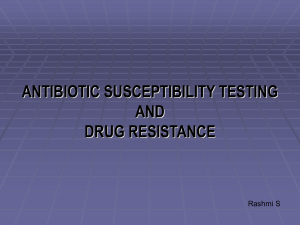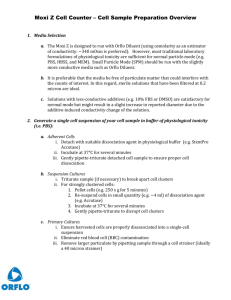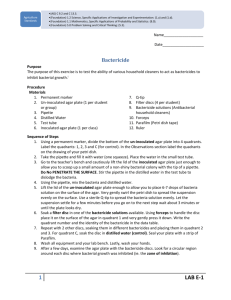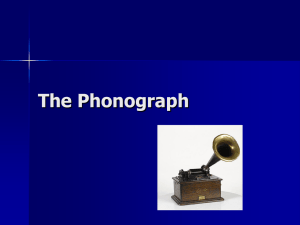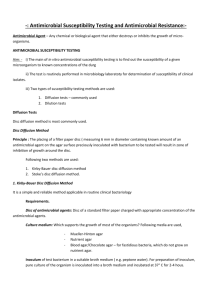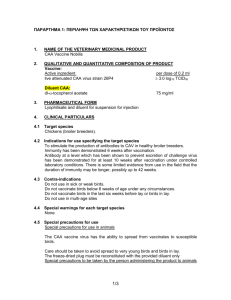zone measurements
advertisement
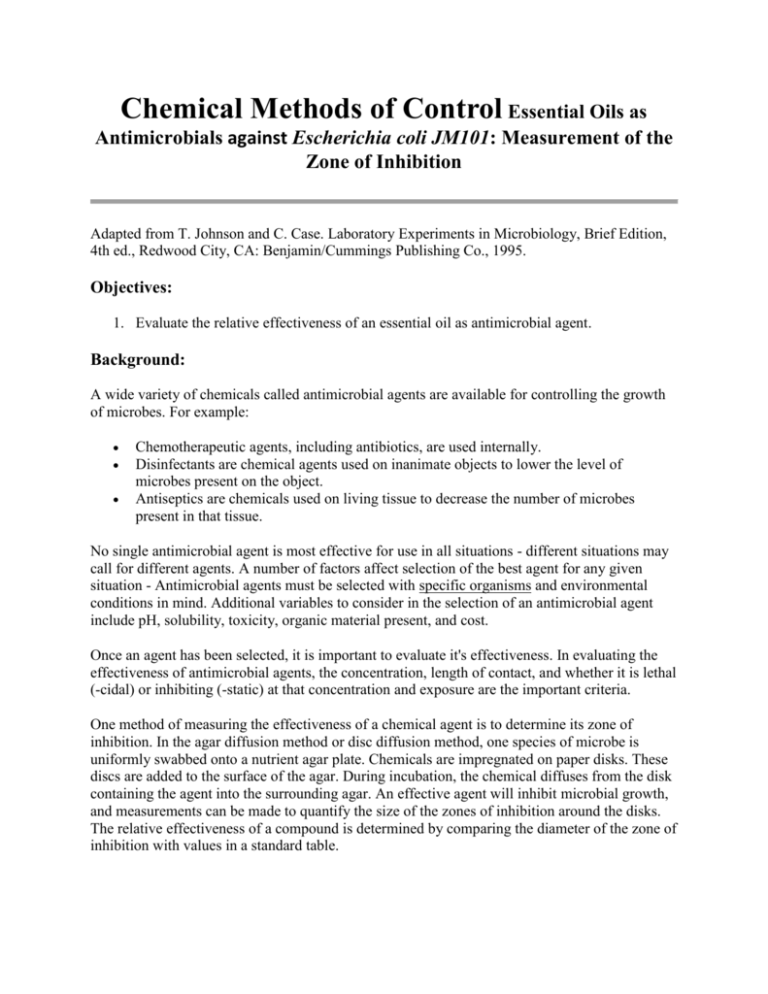
Chemical Methods of Control Essential Oils as Antimicrobials against Escherichia coli JM101: Measurement of the Zone of Inhibition Adapted from T. Johnson and C. Case. Laboratory Experiments in Microbiology, Brief Edition, 4th ed., Redwood City, CA: Benjamin/Cummings Publishing Co., 1995. Objectives: 1. Evaluate the relative effectiveness of an essential oil as antimicrobial agent. Background: A wide variety of chemicals called antimicrobial agents are available for controlling the growth of microbes. For example: Chemotherapeutic agents, including antibiotics, are used internally. Disinfectants are chemical agents used on inanimate objects to lower the level of microbes present on the object. Antiseptics are chemicals used on living tissue to decrease the number of microbes present in that tissue. No single antimicrobial agent is most effective for use in all situations - different situations may call for different agents. A number of factors affect selection of the best agent for any given situation - Antimicrobial agents must be selected with specific organisms and environmental conditions in mind. Additional variables to consider in the selection of an antimicrobial agent include pH, solubility, toxicity, organic material present, and cost. Once an agent has been selected, it is important to evaluate it's effectiveness. In evaluating the effectiveness of antimicrobial agents, the concentration, length of contact, and whether it is lethal (-cidal) or inhibiting (-static) at that concentration and exposure are the important criteria. One method of measuring the effectiveness of a chemical agent is to determine its zone of inhibition. In the agar diffusion method or disc diffusion method, one species of microbe is uniformly swabbed onto a nutrient agar plate. Chemicals are impregnated on paper disks. These discs are added to the surface of the agar. During incubation, the chemical diffuses from the disk containing the agent into the surrounding agar. An effective agent will inhibit microbial growth, and measurements can be made to quantify the size of the zones of inhibition around the disks. The relative effectiveness of a compound is determined by comparing the diameter of the zone of inhibition with values in a standard table. The agar diffusion test is not used to determined whether a chemical is “-cidal” (kills bacteria) or “-static” (inhibits bacteria) - instead this characteristic is determined by the dilution method. In this method the microbe of interest is placed in a tube containing the chemical (at various concentrations) which is being tested. The microbe is then added (subcultured) onto an agar plate. If the microbe grows on the agar the chemical is “-static”; if not, it was killed by the chemical which is then termed "-icidal." Materials: 6 Petri dishes containing LB agar Sterile cotton swab Forceps Disinfectant filled beakers for used tips and contaminated tips and diluent Disks (use a hole punch on filter paper) and antibiotic discs Essential Oils E. coli K12 JM101 which has been grown in LB broth Pure dilution diluent (10% aqueous DMSO, 0.5% Tween 80) and rinse diluent Microcentrifuge tubes Micropipettes and tips Parafilm Ruler and sharpie Procedure: 1. Obtain gloves and clean your work area with the disinfectant provided. Gather supplies. 2. With a marker, divide only the bottom of the petri dish into three sections and label the outside as seen below. Also, label both the top and bottom as seen below. Follow example for each dish - A, B, C, D, paper control dish (P), diluent solution control (S) dish. Make writing small so the growth area is not obscured! A2 A1 A3 Label on Top & Bottom: A, Ms Rios, 10-5-09 3. Prepare the dilutions of the essential oil you choose using the diluents provided to you. You will be carrying out a 1:10, three step serial dilution. Label your microcentrifuge tubes as follows: A, B, C, D, the concentrations, your initials and the oil you are testing. 100 µL oil 100 µL oil A 5-6 drops oil 100 µL oil C B 900 µL diluent 900 µL diluent D 900 µL diluent 4. You will be using approximately 50 microliters of each concentration to impregnate your discs and these dilutions can be made in microcentifuge tubes. a. Drop 5-6 drops of essential oil from the essential oil bottle into a microcentrifuge tube labeled “A” which is 100% essential oil. b. Next, make a 1:10 dilution of the oil using the diluents provided. Using a micropipette and tip, take 100 µL of the concentrated essential oil from “A” and place it into another microcentrifuge tube labeled “B”. With a new pipette tip, add 900 µL of diluent. Mix by flicking with your finger. c. Next, make a 1:100 dilution of the oil using the diluents provided. With a new pipette tip, take 100µL of “B” and place it into a microcentrifuge tube labeled “C” and with a new pipette tip add 900 µL of diluent. Mix by flicking with your finger. d. Next, make a 1:1000 dilution of the oil using the diluents provided. With a new pipette tip, take 100µL of “C” and place it into a microcentrifuge tube labeled “D” and with a new pipette tip add 900 µL of diluent. Mix by flicking with your finger. 5. Obtain a sample of E.coli in LB broth. 6. Using a cotton swab, dip the swab into the E.coli suspension and spread it onto the first plate making sure to evenly distribute it. Repeat for the other 5 plates. Make sure to keep the lid of the agar plate closed as much as possible to avoid further contamination with other microorganisms. Place the used swabs in a beaker of disinfectant. 7. Placing the filter paper discs. a. Using forcepts (rinsing in pure diluent between) dip three discs into the four concentrations of oil and place them onto the corresponding agar plate in the center of each division. Label on Top & Bottom: A, Ms Rios, 10-5-09 b. Prepare the “paper control” (P) dish with three uncoated paper discs as a control (properly labeled) and a “diluent solution control” (S) dish with three paper discs dipped in new pure diluent . c. Other controls will include cinnamon oil discs prepared identically and antibiotic discs. 8. After 15 minutes, place the dishes, right side up, in the incubator at 37 degrees Celsius for 24 hours. Wrap them in parafilm before incubation. 9. Clean up and place potential contaminated materials in autoclave. Discard disinfectants. 10. After 24 hours, the inhibition zone can be measured in millimeters from one side of the zone across the disc to the other side of the zone (diameter). The effectiveness of the essential oil may be determined as in Table 1. Your values are presented as means ± S D of three parallel measurements in chart provided (Table 2). Table 1: Interpretation of Inhibition Zones of Test Cultures Effectiveness Diameter of Zones of Inhibition (mm) Resistant _____________or less Intermediate Between __________ Susceptible ___________ or more Table 2: Essential Oils as Antimicrobials against Escherichia coli JM101: Measurement of the Zone of Inhibition Zone of Inhibition (mm) Disc Essential Oil Concentration 1 1X .1X .01X .001X Paper disc control Diluent paper disc control 1X cinnamon .1X cinnamon .01X cinnamon .001X cinnamon antibiotic Disc 2 Disc 3 Average Zone Standard Deviation Effectiveness Resistant, Intermediate, or Suseptible
